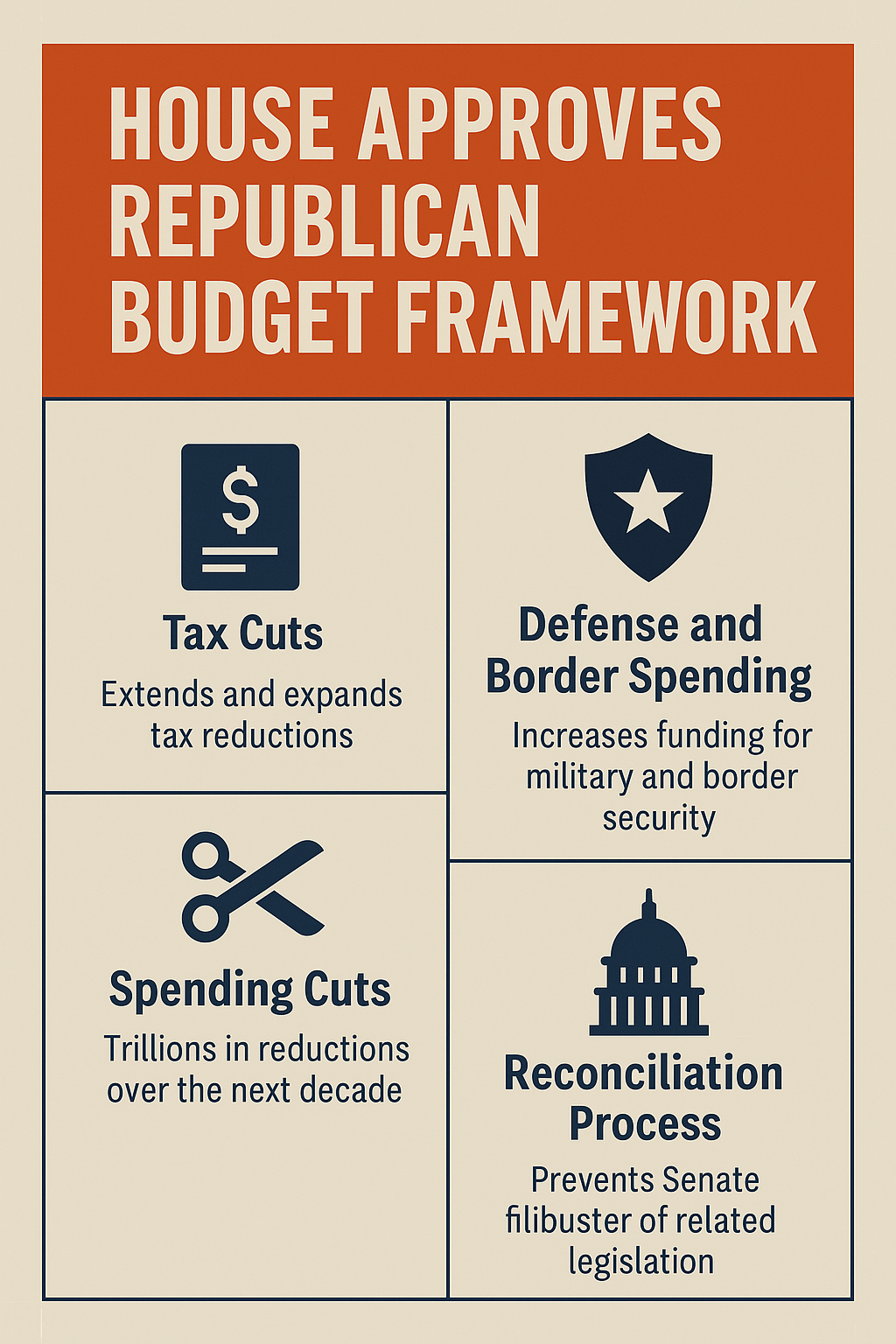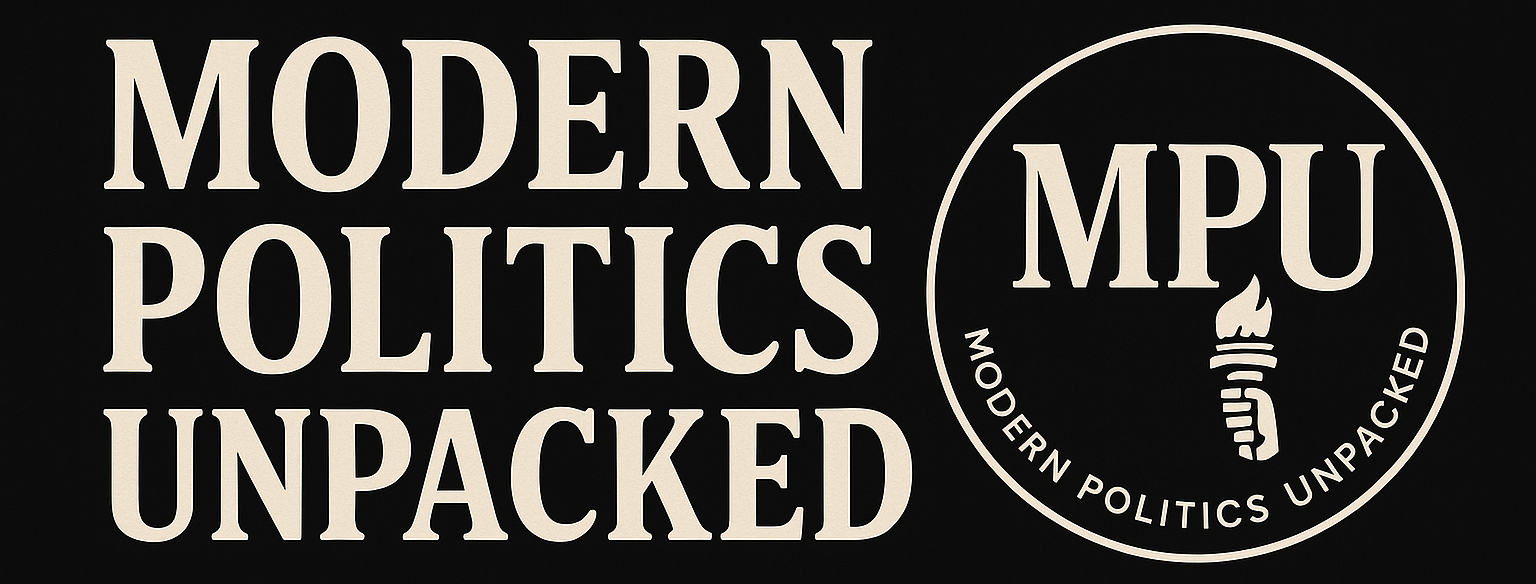Red Lines and Red Ink: Inside the 2025 Republican Budget and What It Means for Americans

In April 2025, the Republican-controlled House of Representatives passed a sweeping budget framework that could reshape the federal government’s role in American life for decades to come. Passed by a narrow 216-214 vote, the budget blueprint is not merely a fiscal document—it’s a political manifesto, packed with policy ambitions from the second Trump administration and guided by long-standing conservative priorities.
At its core, the budget proposes:
- Massive tax cuts, including extensions and expansions of the 2017 Trump tax reforms.
- Deep spending reductions in safety net programs such as Medicaid, SNAP, and the Affordable Care Act.
- Increased defense and border enforcement budgets.
- Structural changes that pave the way for additional right-wing priorities.
This article unpacks the full scope of the budget, the political negotiations that led to its passage, and what it all means for American families, workers, retirees, and future generations.
1. The Road to Passage: Trump’s Legislative Reset
Following his return to the White House, Donald Trump demanded fast action on fiscal priorities. But the GOP’s internal divides between moderates and hardline fiscal conservatives threatened to stall the effort. Speaker of the House Mike Johnson had to balance competing demands to reach a consensus.
Key factors enabling passage:
- Deal-making on discretionary spending cuts: Leadership promised over $1.5 trillion in reductions over ten years to appease the House Freedom Caucus.
- No new entitlements: Republicans committed to avoiding any new social spending, a key demand from deficit hawks.
- Tax cuts framed as pro-growth: Leadership argued that extending and deepening tax cuts would “pay for themselves” through economic expansion.
Despite internal resistance, especially from moderates concerned about cuts to social services, party discipline held firm.
2. A Budget by the Numbers
Here are the topline figures from the approved framework:
| Category | Amount/Change |
|---|---|
| 10-Year Federal Spending Cuts | $1.5 trillion+ |
| Defense Spending Increase | $180 billion over 10 years |
| Border Security Increase | $25 billion over 10 years |
| Tax Cuts | ~$3 trillion estimated revenue loss |
| Medicaid Cuts | $900 billion over 10 years |
| Affordable Care Act Rollbacks | ~$250 billion in projected savings |
| Non-Defense Discretionary Cuts | ~$700 billion |
Source: Congressional Budget Office (CBO) preliminary estimate; GOP Budget Committee Report
The numbers show a federal government being reshaped in favor of military and border priorities, with dramatic reductions in healthcare, education, and housing.
3. Tax Policy: The Return of Trickle-Down Economics?
One of the most defining features of the budget is its recommitment to tax policies first enacted under Trump in 2017. Those tax cuts, originally set to expire in 2025, are now being:
- Extended permanently for individuals.
- Deepened for top earners and corporations.
- Expanded to include incentives for oil and gas production, manufacturing, and capital gains.
Critics say the tax plan will benefit the top 1% disproportionately. According to the Tax Policy Center:
- The richest 0.1% would see an average annual tax cut of $180,000.
- The bottom 60% of Americans would see minimal savings or net losses once benefit cuts are factored in.
Republicans argue that growth will follow. “This budget will supercharge job creation,” Trump said in a press conference. “We are rewarding the doers, the builders, the winners.”
But Democrats and many economists warn that these assumptions are based on debunked trickle-down theories and will instead balloon the national deficit while starving critical programs.
4. Social Safety Net Under Threat
While the budget boosts defense and cuts taxes, it dramatically slashes key social welfare programs:
Medicaid
- The plan proposes a $900 billion cut over 10 years.
- Implements block grants to states, ending the open-ended federal commitment.
- Allows states to impose work requirements and limit eligibility.
SNAP (Food Stamps)
- Tightens work requirements.
- Reduces benefits through “efficiency reforms.”
Affordable Care Act
- Cuts funding for subsidies and Medicaid expansion.
- Allows states to waive essential health benefits.
Housing and Education
- HUD budget cut by 27%.
- Pell Grant eligibility tightened, with spending reduced by $120 billion over a decade.
Experts warn these cuts could push millions into poverty or homelessness. The Center on Budget and Policy Priorities estimates:
"Up to 15 million Americans could lose health coverage by 2028 if this framework becomes law."
5. Military and Border Enforcement: Where the Money Is Going
Not all parts of the budget are shrinking. Defense and immigration enforcement see significant gains:
Pentagon Boost
- Adds $180 billion over 10 years.
- Funds modernization of nuclear arsenal, space command, and drone capabilities.
Immigration and Border
- Allocates $25 billion for:
- Border wall expansion.
- Hiring 30,000 new CBP and ICE officers.
- More detention beds and removal operations.
Homeland Security Secretary Stephen Miller (yes, that Stephen Miller) praised the budget as “a muscular return to the rule of law.”
Opponents say the budget prioritizes militarization over social cohesion. “We’re arming drones and caging children while cutting meals for seniors,” said Rep. Alexandria Ocasio-Cortez.
6. Reconciliation and the Filibuster Loophole
This budget framework does more than express policy desires—it enables Republicans to bypass the Senate filibuster using budget reconciliation.
How it works:
- Budget reconciliation requires only a simple majority in the Senate.
- Republicans can now fast-track legislation aligned with the budget framework—especially tax cuts and spending changes.
With the Senate evenly split and Vice President J.D. Vance as tiebreaker, this makes GOP dominance in Congress more potent than ever.
7. Democratic Resistance: A Battle of Narratives
Democrats immediately denounced the budget as a giveaway to the rich and a betrayal of working Americans.
House Minority Leader Hakeem Jeffries called it:
“A blueprint for American decline, written by billionaires and executed by their servants in Washington.”
Democrats have vowed to fight the coming reconciliation bills line-by-line and to take the battle to the public ahead of the 2026 midterms. Key strategies include:
- Hosting town halls to illustrate local impacts.
- Proposing alternative budgets focusing on climate, healthcare, and education.
- Calling attention to potential Medicare and Social Security reforms that could follow.
8. Public Opinion: Deep Divisions
Polling shows that Americans are deeply divided on the GOP budget:
| Issue | Support | Oppose |
|---|---|---|
| Extending Trump tax cuts | 46% | 49% |
| Medicaid block grants | 33% | 60% |
| Border security increases | 58% | 38% |
| SNAP benefit cuts | 28% | 65% |
| Defense spending increase | 52% | 44% |
Source: Ipsos/Reuters Poll, April 2025
Independents appear especially wary of the proposed cuts to healthcare and education, though Republicans have found success with their framing on border security and tax relief.
9. Economic Impact: Boon or Bust?
Nonpartisan analysts, including the Congressional Budget Office and Moody’s Analytics, project mixed outcomes:
CBO Projections:
- Adds $5.8 trillion to the deficit over ten years.
- Lowers national debt as a % of GDP briefly in early years, but spikes by 2032.
Moody’s Analysis:
- Temporary GDP bump due to tax cuts in 2026–27.
- Long-term drag due to reduced consumer spending from entitlement cuts.
- Risk of recession if Medicaid and SNAP cuts suppress demand in rural and low-income areas.
10. What This Means for You
The most direct impacts of the Republican budget on everyday Americans depend on your income level, location, and life stage.
If You’re a Middle-Class Worker
- May see modest tax cut ($800–$1,200/year).
- Likely to lose access to Medicaid expansion or Affordable Care Act subsidies.
- Could pay more for insurance, child care, and student loans.
If You’re Wealthy
- Major tax benefits on income, estates, capital gains.
- Access to private alternatives for education and healthcare makes you less affected by service cuts.
If You’re Poor or Vulnerable
- Greatest exposure to cuts: Medicaid, food stamps, housing.
- Higher risk of eviction, untreated health issues, or hunger.
If You’re Retired
- No direct cuts to Social Security… yet.
- Medicare reforms expected in future budgets.
- Out-of-pocket costs may rise if subsidies are trimmed.
Conclusion: A Vision with High Stakes
The 2025 Republican budget framework is more than an accounting exercise—it’s a declaration of priorities. It reflects a government willing to starve social spending in order to fund tax relief for the wealthy and build up military and border capabilities.
To supporters, it's a long-overdue correction to bloated federal spending and a chance to restore growth through deregulation and lower taxes.
To critics, it's a reckless gamble that risks pushing millions of Americans into precarity while deepening inequality.
As the reconciliation process moves forward, every line item will be a political battle. But the framework already shows us one thing clearly: America’s budget is now its battlefield.
Sources:
